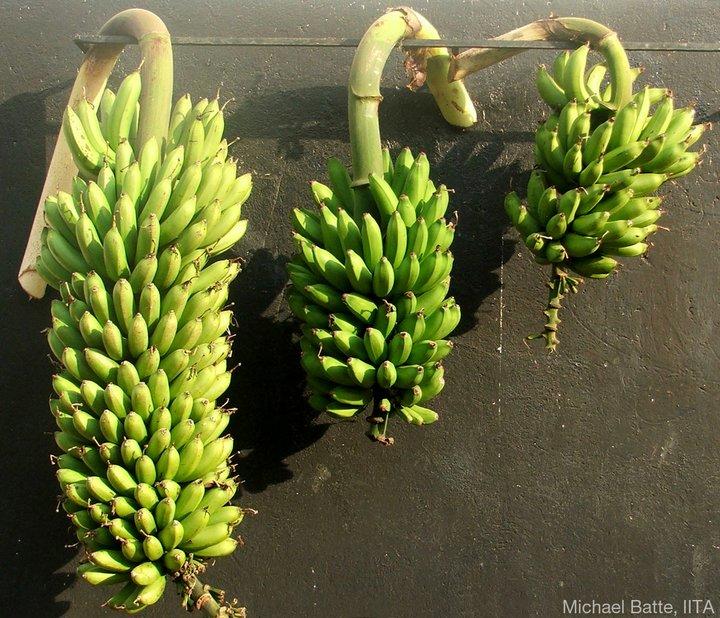The African Great Lakes region to be the testing ground for NARITA bananas

Bioversity International is coordinating the field testing of new high-yielding and disease-resistant bananas as part of a 5-year initiative to increase food security and improve smallholder livelihoods in the African Great Lakes region.
Bioversity International is coordinating the field testing of new high-yielding and disease-resistant bananas as part of a 5-year initiative to increase food security and improve smallholder livelihoods in the African Great Lakes region.
With an annual production of 22 million tonnes, the African Great Lakes region – encompassing Burundi, Rwanda, Uganda and some areas of the Democratic Republic of Congo, Kenya and Tanzania – is a major production area of banana. Here people consume more bananas than anywhere else in the world. They can be eaten raw, boiled, steamed, fried and also be used to produce beer.
The region is home to the East African highland bananas, a unique group of banana varieties that are an important food and cash crop for more than 30 million people in the region. The productivity of these bananas is challenged by low soil fertility, limited rainfall, as well as pests and diseases, such as black leaf streak, nematodes and weevils. Improved varieties could boost yields and improve the livelihoods and nutrition of farmers and communities who depend on these bananas.
On 20 May, the Uganda’s Minister of Agriculture officially launched a 5-year initiative – funded by the International Institute of Tropical Agriculture (IITA) through a Bill & Melinda Gates Foundation grant, and led by IITA in collaboration with the Ugandan National Agricultural Research Organization (NARO) and the Agricultural Research Institute (ARI) of Tanzania – to boost national banana breeding efforts to develop superior East African Highland cooking bananas.
The initiative builds on more than 20 years of breeding efforts by NARO and IITA that led to the development of a set of 25 high-yielding hybrids related to East African highland bananas. Called NARITAs, after the name of the two organizations, these new hybrids have so far been tested on station in Uganda with promising results, but need to be further assessed before they are released to farmers.
In the context of this initiative, Bioversity International will coordinate the field testing of NARITA hybrids in three sites in Tanzania and two sites in Uganda. Working with farmers and researchers, the study will determine their potential for adoption by farmers and consumers.
“Banana breeding programmes have generated a number of high-yielding cultivars with good resistance to pests and diseases, but they tend to involve farmers only at the very end of the breeding and testing pipeline. Farmers also often lack information about the characteristics of the new cultivars when these are presented to them. Adopting a new cultivar always involves a risk for farmers, especially if it has not been tested under local conditions. This may partly explain why the adoption of new cultivars has often been slow and lower than expected,” says Inge Van den Bergh, Bioversity International Senior Scientist and coordinator of the trials. “Moreover, the focus on yield and pest and disease resistance fails to incorporate in the breeding process other traits that are potentially important to farmers and consumers but for which the economic value may be more difficult to assess. This is why, in addition to field trials, we will also do socio-economic baseline studies to better understand the value farmers and consumers put on different traits and the criteria they use when adopting or rejecting a cultivar. This information will be fed back to the breeders so that future hybrids are better adapted to farmers’ and consumers’ needs”.
Two types of trials will be run in parallel: researcher-managed trials to gain data on cultivar performance (mother trials) and farmer-managed trials to facilitate access to and testing of the new varieties by farmers (baby trials). “Male and female farmers will be invited to visit the mother trials and rate the NARITA hybrids several times during the growing cycle and after harvest. Farmers will be able to select 3 to 5 NARITAs they would like to test in their own fields,” explains Van den Bergh. “The baby trials will be fully managed by farmers on their own farms, who will rate the performance of the NARITAs under their actual conditions and in comparison with their local cultivars. Neighbouring farmers will visit the trials, and local processors and traders, as well as consumers, will help test the post-harvest processing and quality traits”.
To maximize the number of farms covered, ‘stand-alone’ baby trials will be set up in other areas of Uganda. Here, each farmer will receive a randomly assigned combination of three NARITAs. They will be asked to rank the hybrids on their agronomic, processing and consumption aspects. This approach allows many farmers to be involved on an individual basis, as in citizen-science or crowdsourcing approaches. Bioversity International is already successfully using this approach in other regions on crops such as wheat, rice, sorghum and beans.
The implementation of the NARITA trials is led by Bioversity International with key international and national partners, such as IITA, NARO in Uganda and ARI in Tanzania.
The initiative is part of the CGIAR Research Program on Roots, Tubers and Bananas. Other partners include six universities (University of Malaya, SLU-Sweden, Stellenbosch University-South Africa, Cornell University-USA, KU Leuven-Belgium, and University of Queensland-UQ-Australia), and national breeding programmes of the Brazilian Agricultural Research Corporation (EMBRAPA) and the National Research Centre for Banana (NRCB) of India).
For more information:
Read the IITA press release
Visit the Musapedia page on NARITA bananas
Photo: On the left, a bunch of NARITA-1, a high-yielding and disease-resistant variety developed by IITA and NARO. The bunches in the middle and on the right are the mother and grandmother of NARITA-1. Credit: IITA/Michael Batte. For more photos of NARITA bananas visit Musarama.
